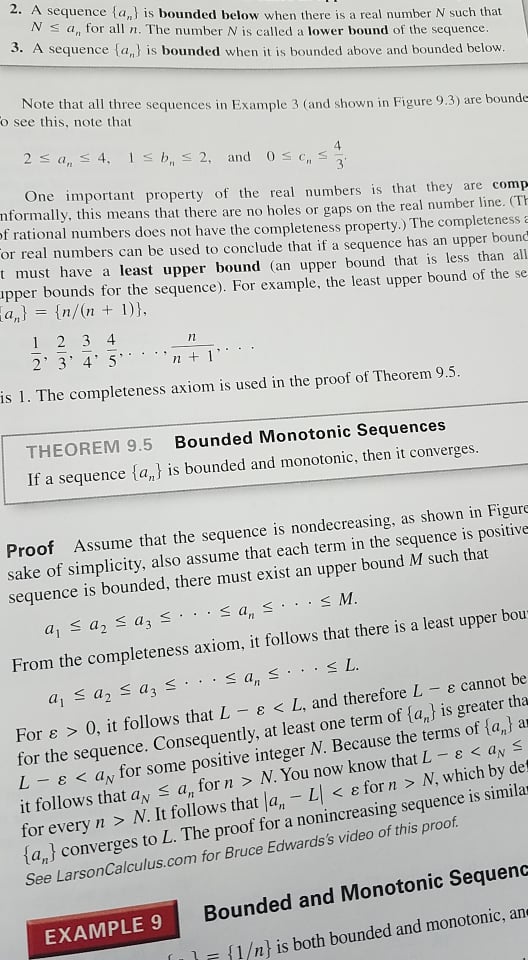
Extracted text: to show that the sequence with the given nth term converges, and (b) use a graphing utility to graph the first 10 terms of the Using a Theorem In Exercises 61-64, (a) use Theorem 9.5 3) 55. a 58. а, %3D 57. a, = 60. а, — Cos n 59, a, = sin In Exercises 61-64, (a) use Theorem 9.5 and (b) use a and find its limit. sequence 1 61. a, = 7 +- 2 62. a, = 5 - n 1 63. an 1 3", 1 64. а, 3 2 + %3D 5n 65. Increasing Sequence Let {a,} be an increasing sequence such that 2 < a,="">< 4.="" explain="" why="" {a,}="" has="" a="" limit.="" what="" can="" you="" conclude="" about="" the="" limit?="" 66.="" monotonic="" sequence="" let="" {a,}="" be="" a="" monotonic="" sequence="" such="" that="" a,="">< 1.="" discuss="" the="" convergence="" of="" {a,}.="" when="" {a,}="" converges,="" what="" can="" you="" conclude="" about="" its="" limit?="" 67.="" compound="" interest="" •="" •="" •="" ..="" consider="" the="" sequence="" {a,}="" whose="" nth="" term="" is="" given="" by="" hb="" 3446="" 82="" l34348="" l12="" 12="">

Extracted text: 2. A sequence {a,} is bounded below when there is a real number N such that Ns a, for all n. The number N is called a lower bound of the sequence. 3. A sequence (a,} is bounded when it is bounded above and bounded below. Note that all three sequences in Example 3 (and shown in Figure 9.3) are bounde o see this, note that 2 s a, s 4, Is b, s 2, and 0s c, s 3 One important property of the real numbers is that they are comp nformally, this means that there are no holes or gaps on the real number line. (TH of rational numbers does not have the completeness property.) The completeness E or real numbers can be used to conclude that if a sequence has an upper bound t must have a least upper bound (an upper bound that is less than all apper bounds for the sequence). For example, the least upper bound of the se a,} = {n/(n + 1)}, 1 2 3 4 2 3 4' 5 n + 1' is 1. The completeness axiom is used in the proof of Theorem 9.5. THEOREM 9.5 Bounded Monotonic Sequences If a sequence {a,} is bounded and monotonic, then it converges. Proof Assume that the sequence is nondecreasing, as shown in Figure sake of simplicity, also assume that each term in the sequence is positive sequence is bounded, there must exist an upper bound M such that aj s a, < az3=""><><>< m.="" from="" the="" completeness="" axiom,="" it="" follows="" that="" there="" is="" a="" least="" upper="" bou="">< a,="" s...="">< l.="" a,="" s="" az="" s="" a3="" s.="" for="" e=""> 0, it follows thatL- E < l,="" and="" therefore="" l="" -="" e="" cannot="" be="" for="" the="" sequence.="" consequently,="" at="" least="" one="" term="" of="" {a,}="" is="" greater="" tha="" l="" -="" ɛ="">< a,="" for="" some="" positive="" integer="" n.="" because="" the="" terms="" of="" {a,}="" ar="" it="" follows="" that="" ay="" s="" a,="" for="" n=""> N. You now know that L- for every n > N. It follows that a, - L < e="" for="" n=""> N, which by det {a,} converges to L. The proof for a nonincreasing sequence is similar See LarsonCalculus.com for Bruce Edwards's video of this proof. EくayS Bounded and Monotonic Sequenc EXAMPLE 9 {1/n} is both bounded and monotonic, an